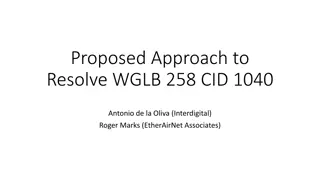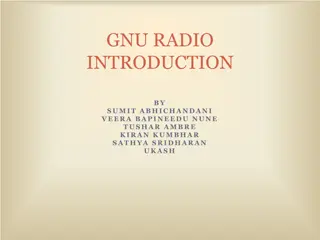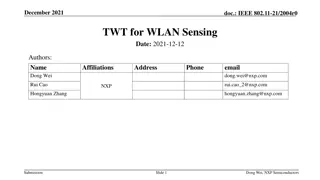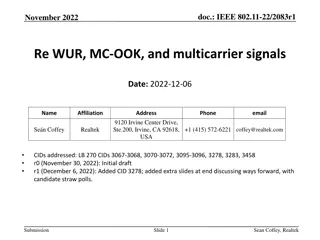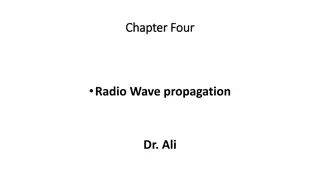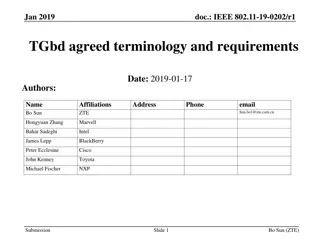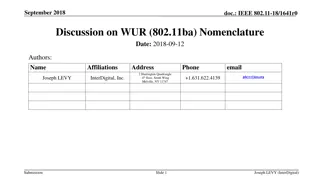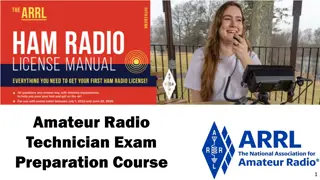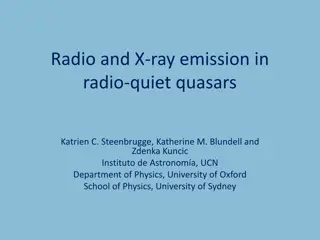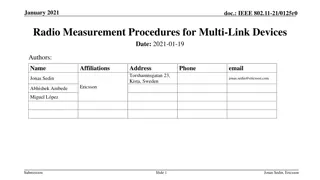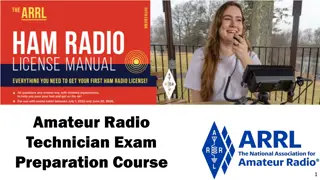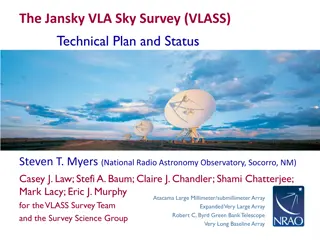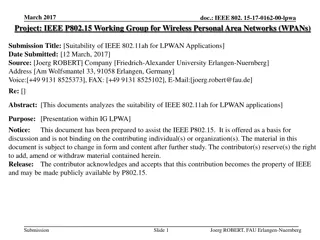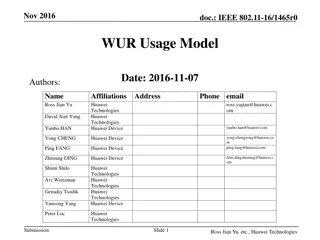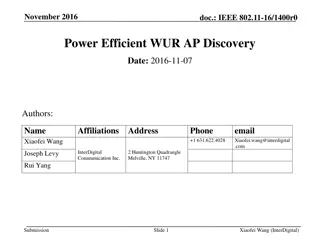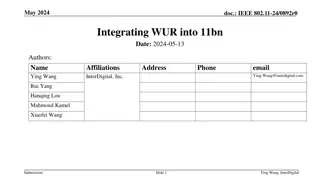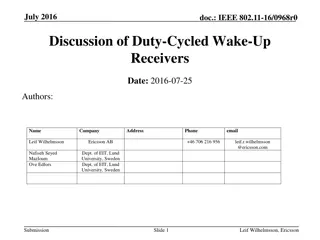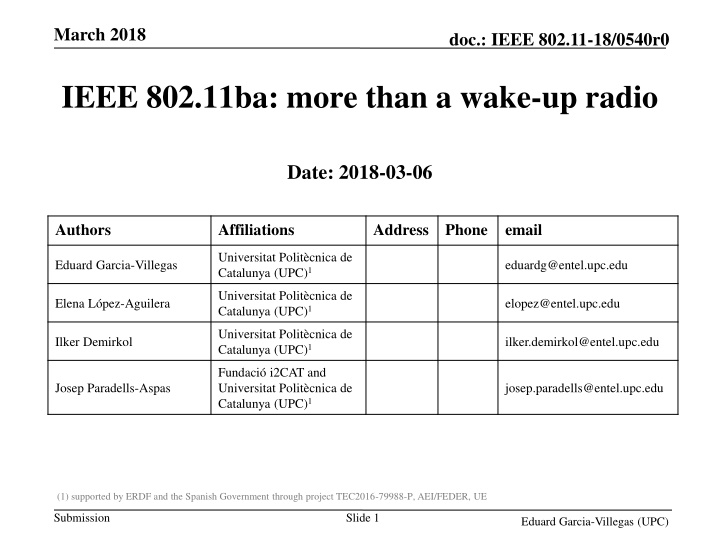
IEEE 802.11ba Wake-Up Radio Applications and Benefits
Explore the potential of Wake-Up Radio (WUR) in IEEE 802.11ba standard for power-saving modes and diverse applications in smart home, warehouse management, livestock monitoring, wearable devices, and intelligent transportation systems.
Download Presentation

Please find below an Image/Link to download the presentation.
The content on the website is provided AS IS for your information and personal use only. It may not be sold, licensed, or shared on other websites without obtaining consent from the author. If you encounter any issues during the download, it is possible that the publisher has removed the file from their server.
You are allowed to download the files provided on this website for personal or commercial use, subject to the condition that they are used lawfully. All files are the property of their respective owners.
The content on the website is provided AS IS for your information and personal use only. It may not be sold, licensed, or shared on other websites without obtaining consent from the author.
E N D
Presentation Transcript
March 2018 doc.: IEEE 802.11-18/0540r0 IEEE 802.11ba: more than a wake-up radio Date: 2018-03-06 Authors Affiliations Address Phone email Universitat Polit cnica de Catalunya (UPC)1 Eduard Garcia-Villegas eduardg@entel.upc.edu Universitat Polit cnica de Catalunya (UPC)1 Elena L pez-Aguilera elopez@entel.upc.edu Universitat Polit cnica de Catalunya (UPC)1 Ilker Demirkol ilker.demirkol@entel.upc.edu Fundaci i2CAT and Universitat Polit cnica de Catalunya (UPC)1 Josep Paradells-Aspas josep.paradells@entel.upc.edu (1) supported by ERDF and the Spanish Government through project TEC2016-79988-P, AEI/FEDER, UE Submission Slide 1 Eduard Garcia-Villegas (UPC)
March 2018 doc.: IEEE 802.11-18/0540r0 abstract The work of the TGba will provide IEEE 802.11 devices with an additional power-saving mode by using a secondary radio or Wake-Up Radio (WUR). The purpose of the WUR is to wake-up the primary connectivity radio (PCR) upon reception of a wake-up packet (WUP). However, the development of a simpler low power radio, capable of receiving messages sent from a fully compliant IEEE 802.11 radio, brings new opportunities. Submission Slide 2 Eduard Garcia-Villegas (UPC)
March 2018 doc.: IEEE 802.11-18/0540r0 TGba focuses on Wake-Up Wake-Up Radio (WUR) project has a narrow focus on the definition of the PHY and the MAC layers of an auxiliary wake-up signal [1] The reception of the wake-up frame by the WUR can trigger a transition of the PCR out of sleep. The WUR is a companion radio to the PCR [2] Submission Slide 3 Eduard Garcia-Villegas (UPC)
March 2018 doc.: IEEE 802.11-18/0540r0 Applications of Waking-up an IEEE 802.11-based PCR Diverse usage models [3] Smart home: one AP serves STAs without power limitations sharing space with tens of low-power battery-driven sensors/actuators of smart home applications. Warehouse: each container/box or each shelf is equipped with sensors that report, the location or state of the stored goods in a warehouse. Cattle farm: livestock carries different sensors monitored from farmer s phone. Wearable devices: personal or body area networks in fitness/health applications connected to a smartphone. Submission Slide 4 Eduard Garcia-Villegas (UPC)
March 2018 doc.: IEEE 802.11-18/0540r0 Applications of Waking-up an IEEE 802.11-based PCR Diverse usage models [3] Moving goods: freighted containers or parcels, equipped with sensors, are located and tracked. Intelligent Transportation System (ITS): portable ITS communication (e.g. as per IEEE 802.11p) devices must be power- efficient (e.g. carried by pedestrians or cyclists). Submission Slide 5 Eduard Garcia-Villegas (UPC)
March 2018 doc.: IEEE 802.11-18/0540r0 Basic operation of IEEE 802.11 WUR PCR Diverse usage models [3] but all based on the same use case: 1. the primary radio (and possibly other systems) of a low-power device is put to sleep to save energy 2. application-level communication with the sleeping device is required 3. Wake-Up Packet (WuP) is sent to wake-up the device s primary radio zZzZz (IEEE 802.11) WURx Submission Slide 6 Eduard Garcia-Villegas (UPC)
March 2018 doc.: IEEE 802.11-18/0540r0 Basic operation of IEEE 802.11 WUR PCR Diverse usage models [3] but all based on the same use case: 1. the primary radio (and possibly other systems) of a low-power device is put to sleep to save energy 2. application-level communication with the sleeping device is required 3. Wake-Up Packet (WuP) is sent to wake-up the device s primary radio 4. normal IEEE 802.11 communication occurs through the primary radio I m awake! (IEEE 802.11) WURx Submission Slide 7 Eduard Garcia-Villegas (UPC)
March 2018 doc.: IEEE 802.11-18/0540r0 IEEE 802.11 WUR beyond wake-up Other proposed usage models (e.g. [4], [5]), regarded as out of scope, were rejected: WuP forwarding Out-of-band signaling Power-save mode for APs (Wake-Up AP) We argue that the presence of a secondary radio in Wi-Fi devices enables a wide range of new applications that go beyond the current scope of TGba Submission Slide 8 Eduard Garcia-Villegas (UPC)
March 2018 doc.: IEEE 802.11-18/0540r0 IEEE 802.11 WUR beyond wake-up WuP forwarding multi-hop path is created on-demand according to source routing or reactive routing approach (e.g. AODV, IEEE 802.11s s HWMP). Sleeping nodes along such path must be woken-up by forwarding WUP Active mesh node Sleeping mesh node WUP transmission Legacy IEEE 802.11 Submission Slide 9 Eduard Garcia-Villegas (UPC)
March 2018 doc.: IEEE 802.11-18/0540r0 IEEE 802.11 WUR beyond wake-up Out-of-band signaling PCR performs normal operation while WUR listens to other channels Synchronization signaling E.g.: Anchor nodes participating in location/positioning Neighbor/Service discovery E.g.: building of an ad-hoc wireless mesh E.g.: Smart scanning (STA discover neighboring APs through WuR) accepted! @2.4GHz Ch.1 @2.4GHz Ch.6 Submission Slide 10 Eduard Garcia-Villegas (UPC)
March 2018 doc.: IEEE 802.11-18/0540r0 IEEE 802.11 WUR beyond wake-up Beyond 802.11 itself Low-power, low-cost, simple IEEE 802.11ba-like receiver can be mounted on devices (with or) without a PCR If present, the PCR may even not be IEEE 802.11-compatible IEEE 802.11 Wake-up, facilitate network onboarding, discovery, etc. of non- IEEE 802.11 devices IEEE 802.15.4 Small appliances may not be able to take advantage of a fully compliant IEEE 802.11 PCR E.g. a lamp holder, garage door opener, automated shade, you name it Submission Slide 11 Eduard Garcia-Villegas (UPC)
March 2018 doc.: IEEE 802.11-18/0540r0 WUR beyond wake-up: example Implemented proof of concept: smart socket [6] based on (pre TGba) 802.11 WUR [7] Circuit capable of receiving OOK-modulated signals generated by a legacy IEEE 802.11 transmitter and consuming in the W scale Transmission of simple commands: switch on/off/intensity/etc. Receiver OOK-modulated signal Legacy IEEE 802.11g transmitter WuR Wall plug Power Adapter Relay switch Appliance Submission Slide 12 Eduard Garcia-Villegas (UPC)
March 2018 doc.: IEEE 802.11-18/0540r0 WUR beyond wake-up: example Implemented proof of concept: smart socket [6] AP fed through smart socket AP automatically switched off when not in use (no associated STAs) for a given period: reduced interference, improved security, save energy: Home: ~25 kWh (yearly savings) Office building: ~1,800 kWh Campus WLAN: ~25,500 kWh Receiver WuR Legacy IEEE 802.11g transmitter Wall plug Power Adapter Relay switch Submission Slide 13 Eduard Garcia-Villegas (UPC)
March 2018 doc.: IEEE 802.11-18/0540r0 WUR beyond wake-up: example Implemented proof of concept: smart socket v2 based on Draft 802.11ba WuR frame Circuit capable of receiving TGba-like OOK-modulated signals generated by SDR transmitter and consuming in the mW scale Transmission of simple commands: switch on/off/intensity/etc. Receiver PIC MCU TGba signal by SDR Submission Slide 14 Eduard Garcia-Villegas (UPC)
March 2018 doc.: IEEE 802.11-18/0540r0 Summary A low-power low-cost and simple radio, capable of receiving messages from an IEEE 802.11 device, can be used for many applications beyond the wake-up use case for which it is initially intended. Support of some of those new applications may involve additional functional requirements. For example, it could allow a Wi-Fi device to talk to non Wi-Fi things and, thus, an 802.11ba-enabled transmitter (e.g. smartphone, smartwatch, etc.) may become the universal remote control Submission Slide 15 Eduard Garcia-Villegas (UPC)
March 2018 doc.: IEEE 802.11-18/0540r0 References May 2017 [1] 11-16/0936r4, A CSD Proposal for Wake-up Radio (WUR), Nov. 2016 [2] 11-16/1045r9, A PAR Proposal for Wake-up Radio, Nov. 2016 [3] 11-17/0029r10, WUR Usage Model Document, Sep. 2017 [4] 11-17/0372r3, Additional usage models for WUR, Mar. 2017 [5] 11-17/0728r2, AP Power Saving, Jul. 2017 [6] Rizzo, Emanuela. Development and performance evaluation of Wi-Fi wake- up radio. MS thesis. Universitat Polit cnica de Catalunya, 2016. [7] Oller, J.; Garcia, E.; Lopez, E.; Demirkol, I.; Casademont, J.; Paradells, J.; Gamm, U.; Reindl, L. IEEE 802.11-enabled wake-up radio system: Design and performance evaluation. Electron. Lett. 2014, 50, 1484 1486. Submission Slide 16 Xiaofei Wang (InterDigital)
March 2018 doc.: IEEE 802.11-18/0540r0 Straw Poll 1 What do you think of the use of IEEE 802.11ba transmissions for purposes beyond Wake-Up (such us those in this presentation)? A. Out of the scope of the IEEE 802.11WG B. Maybe as a future amendment/extension of IEEE 802.11ba C. No opinion Submission Slide 17 Eduard Garcia-Villegas (UPC)

